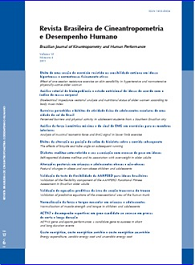Bioelectrical impedance vectorial analysis and nutritional status of older women according.
DOI:
https://doi.org/10.1590/1980-0037.2011v13n6p415Abstract
The objective of the present study was to compare and discuss the nutritional status of older women according to different categories of BMI. Additionally, the study was aimed at introducing the bioelectrical impedance vector analysis (BIVA) as a tool to assess the nutritional status. Thirty-two women (60 years or older, physically independent, and with moderate level of physical activity) were divided into three groups according toBMI classification: G1 (BMI<23 Kg/m2); G2 (23<BMI<28 Kg/m2); and G3 (BMI>28 Kg/ m2). The following variables were analyzed as indicators of nutritional status: body mass and height to calculate BMI, waist circumference (WC), hip circumference (HC), waisthipratio (WHR), bioelectrical impedance (BIVA), resting energy expenditure (REE), biochemical markers of nutritional status (glucose, total cholesterol, and fractions, IGF-1, and leptin). The groups were compared using ANOVA and the Hotelling’s T 2 test for vector analysis. The main findings based on vector displacement showed lower reactance and higher resistance in G1. G3 showed the highest values of CC and leptin, and also lower REE. Therefore, higher BMI suggested at the same time higher cell mass and higher risk of developing chronic diseases. In turn, lower BMI values suggested reduced fat-free body mass. These results confirm the search for specific classification of BMI for the elderly and suggest the BIVA as a viable alternative in physical and nutritional assessment.



